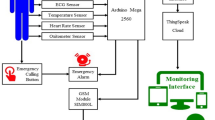Abstract
Many biomedical experiments require a precisely timed real-time (RT) computer interface. Because commonly used desktop operating systems are inherently non-real-time, real-time laboratory computer systems are often based on outdated DOS software or expensive proprietary real-time operating systems. Here we discuss a real-time computing system, based on the free RT-Linux operating system, which we have developed for adaptive pacing control in a clinical cardiac electrophysiology laboratory. This powerful, flexible, and inexpensive system demonstrates that RT-Linux is well suited for real-time biomedical experiment interface. © 1999 Biomedical Engineering Society.
PAC99: 8780-y, 0705Bx, 0705Wr, 8719Nn, 0705Dz
Similar content being viewed by others
Explore related subjects
Discover the latest articles and news from researchers in related subjects, suggested using machine learning.REFERENCES
Barabanov, M. A Linux-Based Real-Time Operating System. New Mexico Institute of Mining and Technology, Department of Computer Science Thesis, 1997.
Barabanov, M., and V. Yodaiken. Introducing real-time Linux. Linux J. 34:19–23, 1997 (http://www.ssc.com/lj/ issue34/0232.html).
Brandt, M. E., H.-T. Shih, and G. Chen. Linear time-delay feedback control of a pathological rhythm in a cardiac conduction model. Phys. Rev. E 56:R1334-R1337, 1997.
Christini, D. J., and J. J. Collins. Using chaos control and tracking to suppress a pathological nonchaotic rhythm in a cardiac model. Phys. Rev. E 53:R49-R52, 1996.
Christini, D. J., and J. J. Collins. Real-time, adaptive, modelindependent control of low-dimensional chaotic and nonchaotic dynamical systems. IEEE Trans. Circuits Syst., I: Fundam. Theory Appl. 44:1027–1030, 1997.
Christini, D. J., V. In, M. L. Spano, W. L. Ditto, and J. J. Collins. Real-time experimental control of a system in its chaotic and nonchaotic regimes. Phys. Rev. E 56:R3749-R3752, 1997.
Cohen, A. Biomedical signals: Origin and dynamic characteristics; frequency-domain analysis. In: The Biomedical Engineering Handbook, edited by J. D. Bronzino. Boca Raton, FL: CRC, 1995, pp. 805–827.
Curry, P. V. L., and D. M. Krikler. Significance of cycle length alternation during drug treatment of supraventricular tachycardia. Br. Heart J. 38:882, 1976.
Epplin, J. Linux as an embedded operating system. Embedded Syst. Programm. 10:96–104, 1997 (http:// www.embedded.com/97/fe39710.htm).
Hall, K., D. J. Christini, M. Tremblay, J. J. Collins, L. Glass, and J. Billette. Dynamic control of cardiac alternans. Phys. Rev. Lett. 78:4518–4521, 1997.
http://cardiodyn.med.cornell.edu/;dchristi/rtlinux/index.html
http://rtlinux.cs.nmt.edu/;rtlinux
http://www.infoworld.com/cgi-bin/displayTC.pl?/97poy.supp.htm
http://www.linux.org
http://www.linux.org/news/index.html has links to several mainstream press articles.
http://www.redhat.com
http://www.troll.no, Troll Tech AS, Oslo, Norway.
Krikler, D., and E. Rowland. Management of supraventricular tachycardia with drugs and artificial pacing. In: Cardiac Arrhythmias: Electrophysiology, Diagnosis, and Management, edited by O. Narula. Baltimore, MD: Williams and Wilkins, 1979, pp. 382–396.
Rinkenberger, R. L., E. N. Prystowsky, J. J. Heger, P. J. Troup, W. M. Jackman, and D. P. Zipes. Effects of intravenous and chronic oral Verapamil administration in patients with supraventricular tachyarrhythmias. Circulation 62:996–1010, 1980.
Ripoll, I. Real-time Linux (RT-Linux). LinuxFocus May, 1998 (http://www.linuxfocus.org/English/May1998/article4.html).
Sun, J., F. Amellal, L. Glass, and J. Billette. Alternans and period-doubling bifurcations in atrioventricular nodal conduction. J. Theor. Biol. 173:79–91, 1995.
Timmerman, M., and J.-C. Monfret. Windows NT as realtime OS? Real-Time Mag. 2Q:6–13, 1997 (http://www.realtime-info.be/encyc/magazine/97q2/winntasrtos.htm).
Timmerman, M., and J.-C. Monfret. Windows NT realtime extensions: An overview. Real-Time Mag. 2Q:14–24, 1997 (http://www.realtime-info.be/encyc/magazine/97q2/winntext.htm).
Yodaiken, V. The RT-Linux approach to hard real-time (A short position paper) (http://rtlinux.cs.nmt.edu/;rtlinux/papers/whitepaper/short.html) (unpublished).
Author information
Authors and Affiliations
Rights and permissions
About this article
Cite this article
Christini, D.J., Stein, K.M., Markowitz, S.M. et al. Practical Real-Time Computing System for Biomedical Experiment Interface. Annals of Biomedical Engineering 27, 180–186 (1999). https://doi.org/10.1114/1.185
Issue Date:
DOI: https://doi.org/10.1114/1.185




